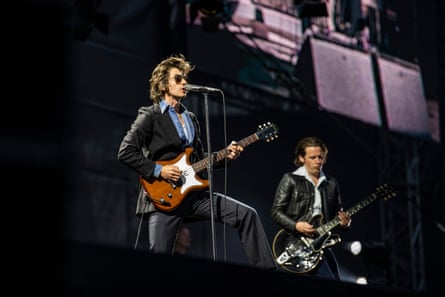‘Very good,” Alex Turner exhales after delivering the final crunching note of Teddy Picker, hitting the nail on the head. The Arctic Monkeys frontman, dressed like a Laurel Canyon troubadour in a wide-collared denim shirt and blazer, his shagpile barnet falling towards a pair of black-lensed aviators, has barely said another word in the opening half hour of the band’s first stadium tour, preferring instead to conduct a storm of rock music that’s as surprising as it is thrilling in its brutish simplicity.
Released last autumn, the group’s seventh album The Car suggested that this run of shows might hit a few speed bumps. Its songs – an ornate, string-led mix of spy caper jazz-pop and needling ballads – required puzzling out, and perhaps wouldn’t be suitable for deployment in venues of this size.
This meticulously paced set, though, shows that context is everything. Cutting that sense of uncertainty off at the knees, Turner and his bandmates – guitarist Jamie Cook, bassist Nick O’Malley and the exceptional, propulsive drummer Matt Helders – opt to start with Mardy Bum, returning a breakthrough hit to the fold after some time in exile, and they keep their foot down. A righteously loud Don’t Sit Down ’Cause I’ve Moved Your Chair is next, before Helders tumbles into Brianstorm’s frenzied intro.
These early exchanges highlight Turner’s skill as a straight-up riff writer – much of his catalogue might be viewed differently if conjured by Jack White or Queens of the Stone Age’s Josh Homme – and many of the staccato leads he shares with Cook are boisterously taken up football chant-style from within the confines of the stadium pitch.
Following a surging The View from the Afternoon, though, Turner pointedly slips his guitar off and wanders towards the front row, suddenly a lounge lizard framed with Super 8-style lens flare on the screens hanging either side of the stage. Four Out of Five follows, a new bossa nova arrangement drawing out the recorded version’s sting, with an undulating second stanza attuned to Arctic Monkeys’ current studio excursions.
The Car’s stately opener There’d Better Be a Mirrorball unfolds as the sun sets, its sweeping orchestral elements expertly recast as psych-leaning keys, and a couple of old stagers are drawn into its orbit: Suck It and See has Turner exaggeratedly reaching for the crowd like a peak-ham Tom Jones, while 505 is strung out, its synth drone pushed towards Velvet Underground levels of prominence. Its humming patience is rewarded with a stellar payoff as the chorus lands in a flurry of chunky chords.
At this point, the staging becomes particularly effective. It is very simple – no pyro or stadium pomp here – but the lighting and video work creates a mood in a way that no confetti cannon could. During a thunderous Do I Wanna Know?, Cook is framed by deep red circles that punch out of the darkness, immediately recalling Elvis’s comeback special. Throughout, Turner looks like he’s just ambled on to the studio floor at The Old Grey Whistle Test, and during the riff on John Cooper Clarke’s I Wanna Be Yours, he is picked out on screen against warm oranges and shocking blues, looking for a moment like Van Morrison on the sleeve of It’s Too Late to Stop Now. Deliberate or not, in these moments it moves beyond pastiche and into something more pointed, visually situating Arctic Monkeys in a shape-shifting rock tradition.
after newsletter promotion
A push-pull dynamic settles in as they pepper the latter stages with a scratchy My Propeller and a borderline euphoric Fluorescent Adolescent, calling to mind Turner’s assertion in the Guardian that The Car was partly about “switching the ‘rock band’ bit on and off”.
Flicking that switch, the encore is a notable success. I Bet You Look Good on the Dancefloor and R U Mine? signal the expected carnage and set off pogoing mobs of lads out on the floor, but they follow a take on The Car’s Sculptures of Anything Goes that retains its foreboding bass notes and synth stabs while retrofitting it with a hulking, apocalyptic rock edge. It is rapturously received, suggesting that these new songs can be muscular stadium-fillers all on their own. Yes, very good.

